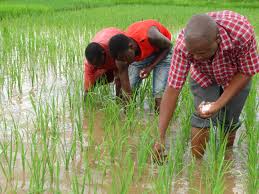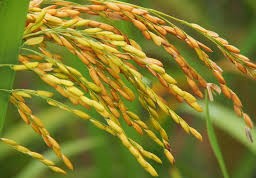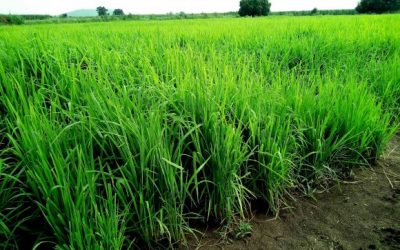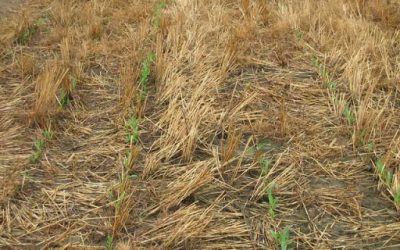Nutrient management in Rice growing.

Before applying fertilizers, you have to take into consideration the soil condition of your field through semiannual or annual soil testing, before applying any fertilization method. No two fields are the same, nor can anyone advise you on fertilization methods without taking into account your soil’s test data, tissue analysis and crop history of your field. However, we will list the most common rice fertilization schemes, used by a considerable number of farmers.
A common rice fertilization scheme that is used by a great number of rice farmers involves 2 major fertilizer applications: The first application takes place at roughly the same time with planting or transplanting (or about 20 days later) and the second takes place about 45-60 days after the first application. Many farmers apply 0,5 tons of N-P-K 30-10-10 per hectare at the day of sowing/planting (or 20 days later). About 45-60 days after the first application, they apply 0,2-0,3 tons of N-P-K 40-0-0 or 33-0-0 per hectare. Keep in mind that 1 ton = 1000 kg = 2.200 lbs. and 1 hectare = 2,47 acres = 10.000 square meters.
However, these are just common patterns that should not be followed without making your own research. Every field is different and has different needs. Your rice plants may or may not give higher yields after the application of fertilizers. You can seek advice from a licensed agronomist after conducting a soil analysis.
Nitrogen is the most restrictive nutrient for rice production. Nitrogen is very important for the increase of plant height, leaf size, panicle number and for a high yield per hectare. Rice needs Nitrogen in order to develop an adequate number of panicles. The crucial period in which many farmers apply N is two weeks after transplanting or 21 days after sowing.
Moreover, many farmers proceed to N applications before seeding and flooding the field. Nitrogen application may occur in dry soil which we will irrigate immediately. Alternatively, we can integrate it and flood the field after 3 to 5 days. An early application may also take place, in the form of ammonium. We can apply it onto dry soil, just before the flooding procedure. We should take into consideration that once we applied early N, the field shall be flooded within 5 days. Flood normally integrates N into the soil and protect it from losses. However, keep in mind that every field is different and has different needs.
Nitrogen Deficiency
One of the most common problems in rice production is Nitrogen deficiency. It usually takes place during crucial growth stages (panicle development), when plants need a greater amount of nitrogen.
We can identify these deficiencies by an intense discoloration of the crops. We can manage nitrogen deficiencies by following the measures below.
– Efficient N fertilizer application.
– Sufficient plant spacing is required.
– Proper water management. Many farmers claim that their field should be continuously flooded.
– Control of weeds that compete against rice for N (very important)
– Consulting a local licensed agronomist is suggested.
Nitrogen Excess
Nitrogen application in sufficient amount helps rice grow faster and provide us with high-quality grains. However, many farmers apply a larger amount than the one that rice needs. Excessive nitrogen use can lead to rich growth which attracts a lot of pests. Some farmers can recognize nitrogen excess by looking at the leaves. In most cases, they have an abnormal green color. Furthermore, plants may have thin stems. Farmers can normally prevent nitrogen excess by examining soil nitrogen consistency and then apply sufficient N that meets the needs of rice plants.
Phosphorus (P)
Phosphorus is very important in the early growth stages of rice plants. It contributes to the development of strong roots. Soil pH has a major role in P availability. Many rice farmers claim that the ideal phosphorus availability to rice happens when soil pH is below 6,5 (ask a certified professional Agronomist).
Potassium (K)
Potassium (K) is also very important for achieving good rice yields. Potassium (K) contributes to plants’ disease resistance, root enlargement, and thickness, leaf durability, panicle initiation and development. Potassium deficiencies have a great impact on crop growth. Experienced rice farmers claim that they can identify these deficiencies by the following symptoms.
– Dark spots on older leaves. Dark green plants with yellow to brown leaves.
– Leaves in lower parts of the plant may tend to bend downwards.
– Leaves in the upper part of the plant are short, with gloomy green .
– Necrotic spots on panicles.
– Unhealthy root condition. Roots are black with decreased density and length.
– Early wilt of the leaves.
Experienced rice farmers can manage these problems by following the measures below.
– Using high-quality seeds with sufficient pest and disease resistance.
– Proper application of N and P, but avoiding excessive use.
– Consulting


